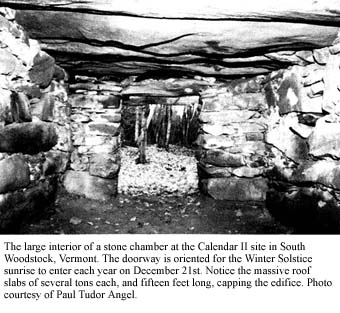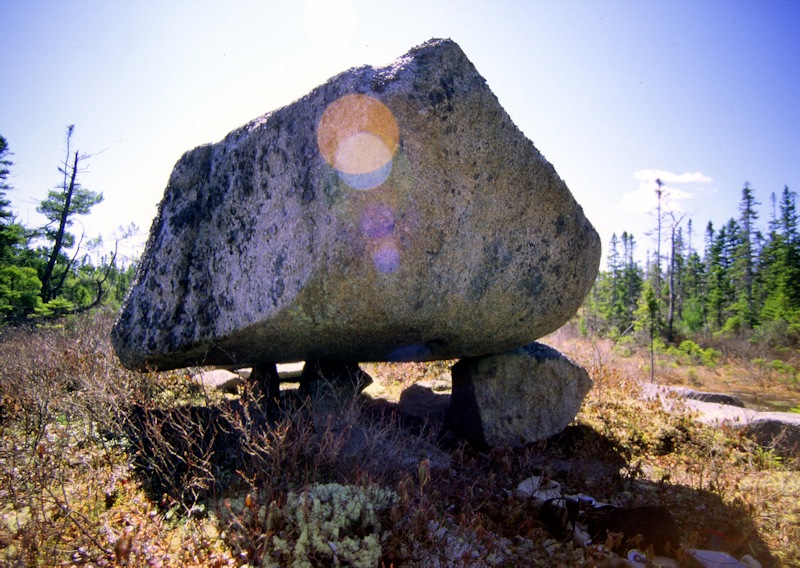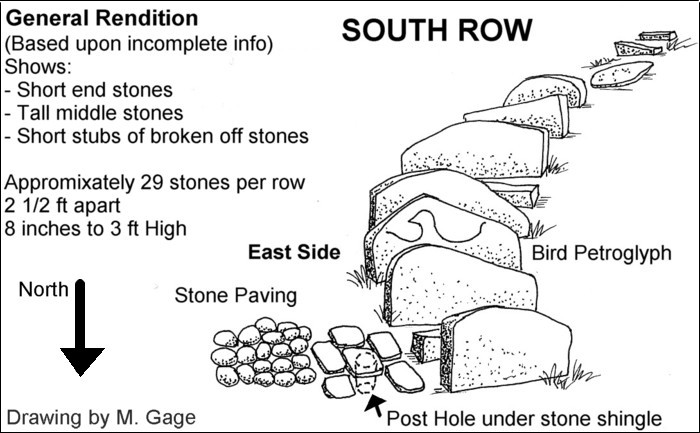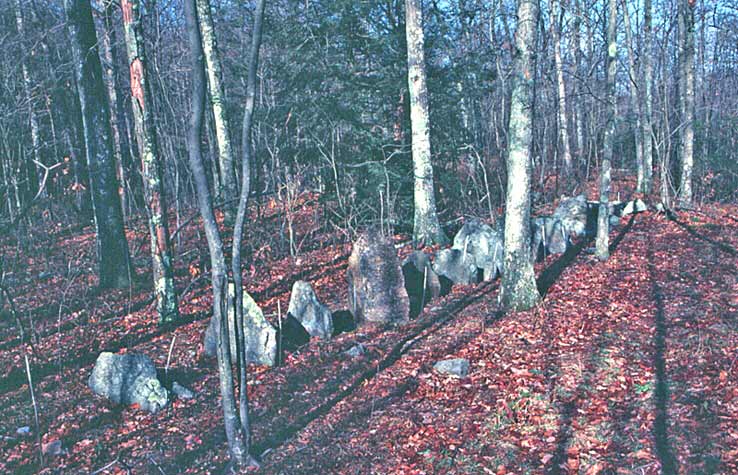We should be able to rule out bronze age European settlers. They should have left bronze shields or other such tools to remind us of them, not just the stones. I heard that hammer dated thousands of years ago have been found, but that doesn't mean that they weren't Amerindian, right?
One theory is the Solutrean hypothesis or versions of it, by which Europeans arrived in the paleolithic era and could have been the builders. This theory seems quite unlikely, the main reason being the difficulty in crossing the North Atlantic in large enough numbers to help alot with populating New England and eastern Canada (100-500 people?), even if they mixed with natives. Even the amerliorative factors don't seem to overcome this. Those factors are:
- There was an ice sheet connecting NW Europe to Eastern Canada. maybe they could walk on the ice or camp on it while sailing in primitive boats, canoes or rafts.
- They could fish for food. (But they wouldn't be able to hunt normal land mammals, except things like seals)
- Inuits got to Greenland and in some accounts to NW Europe before Columbus
- Vikings got to Eastern Canada and settled there a bit with 120+ people
- Modern reenactors succeeded in crossing in primitive boats in small numbers.
- The continents and shorelines were a bit closer and bigger then due to the ice age (eg. Ireland was connected to England)
- There were cases where animals like monkeys crossed the Atlantic. I know this is very weird. Scholars' most common explanation is "rafting" with floating swampland (Monkey Ancestors Rafted Across the Sea to North America, http://www.sciencemag.org/news/2016/04/ ... th-america)

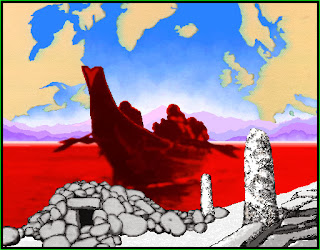
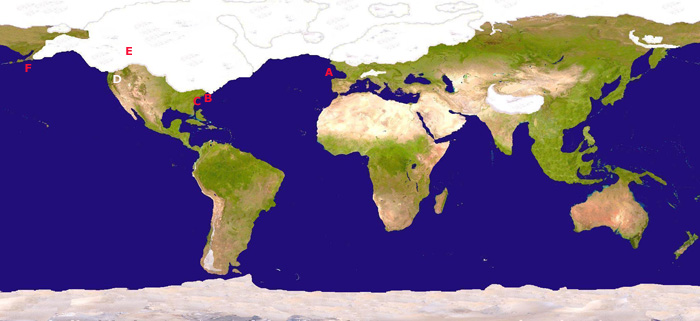

And the logistical issue is just the biggest barrier in my mind. There are others, like whether Northeast Amerindian X, R1, R1B, and C DNA is both precolumbian and directly related to the same haplogroups by those names in Western Europe. And if not, then we are forced to think about whether the European settlers in ancient times only mixed with the Indians without leaving much trace.
The next set of questions is: Regardless of whether the Amerindians or pre-columbian European settlers built the megaliths, can we date their construction reliably? Can't we look at things like carbon dating, soil overgrowth, weathering of rock incisions, as well as any skeletons or artefacts at the sites? Haven't mainstream scientists tried to, using all these tools
Let's consider where some of these supposed megalithic sites have been identified.
The Bulletin of the Archaeological Society of Connecticut (No. 38 1973. pp. 77-89) recorded how:
If this account is true, it suggests that Amerindians were digging mounds and making boulder heaps themselves, even in the copper age, if not earlier.Between 1952-54, Frank Glynn excavated two stone heaps at Pilot’s Point on coast of Connecticut. Heap I, an oval shaped stone mound, measured 12 feet by 21 feet with a maximum elevation of 2 feet. Heap II, another oval shaped stone mound, measured 9 feet in diameter with maximum elevation over two feet. It was built against a large glacial boulder. A small shell heap abutted the heap. ...
Artifacts recovered included “stemmed and barbed projectile points, a stemmed knife, a scraper and a chisel, suggestive of the Archaic-Woodland overlapping periods.” In addition, rim shards, a mortar and pestle, and hoes and spades described as “Adena-like” were recovered. Glynn noted that “The immediate sealing-off of fires either by covering them with stone or rolling a large stone into them was evident.” Heap II was a mix of burnt stone and shell and had strong evidence that the glacial boulder was used as a reflector oven for cooking clams. Artifacts recovered included “Quartz cores, flakes and chips …broken choppers and scrapers …”
http://www.stonestructures.org/html/sou ... #Subject-1
Wikipedia says:
https://en.wikipedia.org/wiki/Metallurg ... an_AmericaIndigenous Americans have been using native metals from ancient times, with recent finds of gold artifacts in the Andean region dated to 2155–1936 BCE.[1] and North American copper finds dated to approximately 5000 BCE.[2] The metal would have been found in nature without need for smelting techniques and shaped into the desired form using heat and cold hammering techniques without chemically altering it by alloying it. To date "no one has found evidence that points to the use of melting, smelting and casting in prehistoric eastern North America."
James Mavor & Byron Dix write in the book "Manitou: The Sacred Landscape of New England’s Native Civilization: (Rochester, VT: Inner traditions Inc., 1989, pp 66, 82) about how they
http://www.stonestructures.org/html/sou ... #Subject-1investigate a group of 110 stone mounds in Freetown, Massachusetts during the early 1980’s. ... A single stone mound was selected for archaeological excavation. The excavation recovered charcoal from two features and was c-14 dated 875 +/- 160 years B.P. and 875 +/- 150 years B.P. In additional, the excavation found 120 pieces of red ochre, and possible stone tools (hammerstones, scrapers, and anvils). “We [Mavor & Dix] conclude from the excavation that the mound, and by implication many others, was built by pre-historic Native Americans for ceremonial use, and was certainly not the result of English colonial field clearing.”
This is more proof of Amerindian mound building in New England.
Dennis E. Howe writes in “The Beaver Meadow Brook Site: Prehistory on the West Bank at Sewall’s Falls, Concord, New Hampshire”:
The Stone structures website commented about this:“Feature 5 This feature, located in excavation units N0E0 and N1E0, consisted of stacked cobbles and stones … and has been identified as a cairn. The total weight of the stones and cobbles was 124.5 lbs (274.5 kg). It extended from a depth of 48 cm to 83 cm. It is likely that it was associated with the cremated human remains, Feature 9, and Feature 4. No other features like this were found on either bank of the river in the Sewall’s Falls area.”
http://www.stonestructures.org/html/sou ... #Subject-1Feature 5 at the site was classified as a cairn and associated with feature 9 a cremation burial. Feature 9 had “A Radiocarbon date of 5155 +/- 190 years B.P. (GX-14009) was obtained from charcoal excavated from immediately below the feature.” (pp. 61)
Paul Angel names a subterranean chamber in Vermont called "Calendar II" in Vermont as one of the megalithic structures:
John Hugh writes about megaliths that " they exist in, ... in the north eastern states of America. New England and New York State have thousands of recorded megalithic and lithic sites (Mega = big, Lithic = stone)". He doubts that they are root cellars because "there are no air vents, the floor is often bedrock, they are built upon magnetic anomalies, and the huge megaliths that often make up the lintels are of no apparent use to 'root cellars'", adding:At the center of this cosmic place is a beautifully preserved underground chamber called Calendar II because it is oriented to the midwinter sunrise. If you sit inside the chamber and look out the entranceway on the morning of the winter solstice, December 21, the sun will rise in the center of the entrance. Analysis by archeoastronomer Byron Dix shows that the chamber was also used in lunar observations and eclipse prediction. This is only one of many such sites found all over New England. This chamber, like most other such chambers, is located over an underground water spring ....
The overhead lintel stones weigh approximately three tons each.
http://planetvermont.com/pvq/v9n1/megaliths.html
http://megalithomania-america.blogspot. ... cient.html...It is generally accepted by researchers that these sites were built by the Native American populations of the area a few hundred years ago, but carbon dating, archaeoastronomical alignments, scientific earth energy tests and oral histories have pushed the dates much further back than originally thought.
He talks about his visit to a set of underground chambers called Calendar I in VT, saying:
Then he talks about another chamber called the "Eagle Chamber".The telluric lines... bounced off the larger stones inside the chamber in a zigzag fashion and out of the chamber forming a spiral at the entrance. Telluric currents are currents that run across the surface of the earth and are attached to the magnetic field. They fluctuate in strength throughout the day, and when harnessed, the energy can be used to alter consciousness and even affect the fertility of seeds and grains if placed correctly. Several sites in New England were tested by John Burke and Kaj Halberg whilst researching for their book 'Seed of Knowledge, Stone of Plenty' (Council Oak Books, 2005). They used sophisticated Magnetometers and Electric Volt Readers
This idea of Telluric lines sounds strange to me, but they are claiming to pick it up with electronic equipment.
He then talks about other places:
http://megalithomania-america.blogspot. ... cient.htmlCalendar II is a nearby megalithic chamber that has much larger stones making up the interior lintels. This is the biggest chamber in Vermont, measuring ten feet by twenty feet. ....There are seven massive lintel stones that span this width and the entrance is aligned to the Winter Solstice sunrise. According to Mavor and Dix, it can also be used as an eclipse predictor and for lunar observation.
Thanks to its new name, 'America's Stonehenge', (formerly 'Mystery Hill') has become the most famous megalithic structure in New England. It is a vast astronomical complex based in North Salem, New Hampshire, with standing stones, a sacrificial table, stone chambers and astronomical alignments.
[The site manager] told us that carbon dating of the site over the years put the time frame from 2000BC to 200AD. Unknown megalithic builders constructed a 12-acre astronomical stone calendar ... In 1975 the "true north stone" was determined to have lined up with the then Pole Star Thuban, dating to around 1750 BC (3). It is believed that at that time period, a very large body of water, which was fed by the Merrimack River, shored near the Mystery Hill area. ... The style is again very similar to European megalithic sites. A notable feature is the "T" shaped "oracle" chamber that has an unusual speaking tube that comes out below the 'sacrificial table', a 4.5 ton block of granite that is said to have been used for sacrifice!
A dating method of lining up stars seems quite unreliable. If you don't know how old the site is or what stars the rocks lined up to (if any), how can you date it and call it astronomical by saying that a rock on the site lines up with a star's location at a certain year?
Let me add that calling the central frame-cut slab a "sacrifice stone" also seems less likely to me because it looks like a common lye stone used by 18th c. Anglo colonists.
Joseph A. Citro and Diane E. Foulds write in Curious New England: The Unconventional Traveler's Guide about beehive shaped undergound chambers in New England, claiming that "carbon-dating suggest[s] they were there" in the BC period. "Native Americans are as baffled by them as we are. .... Why isn't the state attempting to solve the puzzle?"
